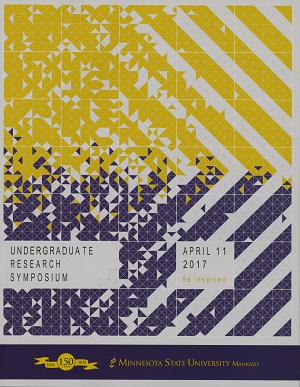The Effects of DIO2 and DIO3 Expression on Seasonal Reproduction in a Seasonally Breeding Animal
Location
CSU Ballroom
Start Date
11-4-2017 10:00 AM
End Date
11-4-2017 11:30 AM
Student's Major
Biological Sciences
Student's College
Science, Engineering and Technology
Mentor's Name
Rachel Cohen
Mentor's Department
Biological Sciences
Mentor's College
Science, Engineering and Technology
Description
Thyroid hormone (TH) is critical for testes development and a decrease in TH can cause hypogonadism, which decreases gonadal function. Deiodinase is responsible for the activation and inactivation of TH from the precursor, thyroxin (T4). Type 2 deiodinase (DIO2) produces the biologically active thyroid hormone, triiodothyronine (T3), while type 3 deiodinase (DIO3) produces an inactive isoform, reverse triiodothyronine (rT3). In developing testis, DIO3 expression is upregulated and DIO3 deficiency results in low T3, causing a drastic reduction in testis size. In seasonally breeding animals, testicular morphology and function are altered in the breeding (BS) compared to non-breeding season (NBS), such that they go through periods where the gonads are inactive (hypogonadism). Studying a seasonally breeding Green anole lizard, Anolis carolinensis, will allow us to examine natural changes in DIO2 and 3 expression patterns that might mediate these changes. Male green anole testes grow and produce steroid hormones and sperm during the BS, while they regress and the lizards no longer reproduce during the NBS. We are using quantitative polymerase chain reaction (qPCR) to measure how DIO2 and DIO3 mRNA expression in the testes differs between the BS and NBS. Since the presence of T3 is important for testicular maturity and development, we expect to find that testes from breeding lizards will have upregulated DIO2 and downregulated DIO3 compared to NBS testes. This will support the idea that TH is critical for regulating seasonal testicular changes, which may help us to understand how TH is involved in hypogonadism.
The Effects of DIO2 and DIO3 Expression on Seasonal Reproduction in a Seasonally Breeding Animal
CSU Ballroom
Thyroid hormone (TH) is critical for testes development and a decrease in TH can cause hypogonadism, which decreases gonadal function. Deiodinase is responsible for the activation and inactivation of TH from the precursor, thyroxin (T4). Type 2 deiodinase (DIO2) produces the biologically active thyroid hormone, triiodothyronine (T3), while type 3 deiodinase (DIO3) produces an inactive isoform, reverse triiodothyronine (rT3). In developing testis, DIO3 expression is upregulated and DIO3 deficiency results in low T3, causing a drastic reduction in testis size. In seasonally breeding animals, testicular morphology and function are altered in the breeding (BS) compared to non-breeding season (NBS), such that they go through periods where the gonads are inactive (hypogonadism). Studying a seasonally breeding Green anole lizard, Anolis carolinensis, will allow us to examine natural changes in DIO2 and 3 expression patterns that might mediate these changes. Male green anole testes grow and produce steroid hormones and sperm during the BS, while they regress and the lizards no longer reproduce during the NBS. We are using quantitative polymerase chain reaction (qPCR) to measure how DIO2 and DIO3 mRNA expression in the testes differs between the BS and NBS. Since the presence of T3 is important for testicular maturity and development, we expect to find that testes from breeding lizards will have upregulated DIO2 and downregulated DIO3 compared to NBS testes. This will support the idea that TH is critical for regulating seasonal testicular changes, which may help us to understand how TH is involved in hypogonadism.
Recommended Citation
Kang, Hyejoo. "The Effects of DIO2 and DIO3 Expression on Seasonal Reproduction in a Seasonally Breeding Animal." Undergraduate Research Symposium, Mankato, MN, April 11, 2017.
https://cornerstone.lib.mnsu.edu/urs/2017/poster-session-A/14



